One of the biggest lessons that I’ve learned throughout the years of playing this game is that, compared to some of the larger popular games like Yu-gi-Oh! and Magic the Gathering, Weiss is, for the most part, a solitaire game. Comparing it to some of the more popular games in the West, it’s closest comparison, I’d argue, is that of Pokémon.

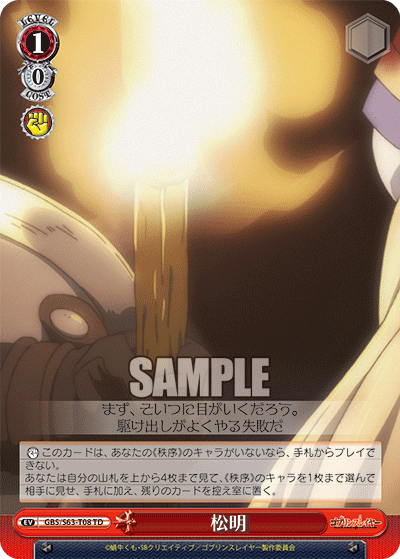
One key problem is that the only direct form of interaction with your opponent is done with backup cards. There really aren’t that many opportunities otherwise for your opponent to directly intervene otherwise. The only other use case is often that of character abilities, but rarely do those abilities activate during your opponent’s turn. On top of that, many of these abilities are automatically activated, preventing any choice or agency to begin with.
Backups, especially those of the character variety, are only usable during your opponent’s turn and only during the trigger step of your opponent’s attacks. Furthermore, to add to the issue, backup triggers can be completely ignored due to a gameplay mechanic: siding.

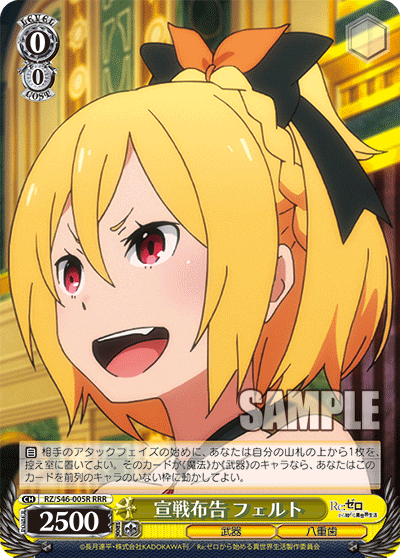
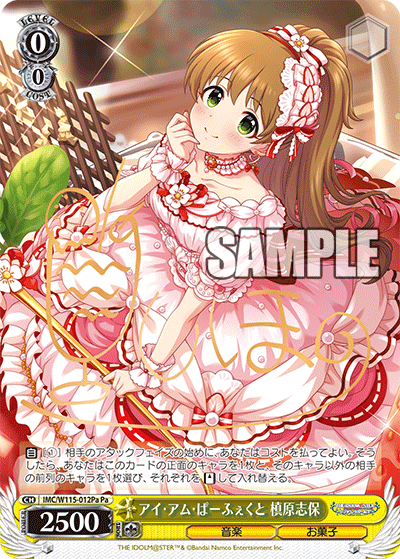
RZ/S46-005R-RRR 宣戦布告 フェルト (center)
IMC/W115-012Pa-Pa アイ・アム・ぱーふぇくと 槙原志保 (right)
There aren’t that many profiles that really function during your opponent’s turn. Some of the most common are shown here. Even then, there’s not as much agency allowing you to choose how you wish to activate or respond with your defensive abilities. There’s a number of different complications and conditions that may follow. For example, in the case of the mill runner, one of the classic defensive cards, you can only move to a position that is empty in your front row. If your front row is full, which is very common, especially in the early-mid game, the profile will fail to provide any defensive utility.
On top of this, the biggest problem with many of these profiles is the fact that they activate at the start of your opponent’s attack phase or during an opponent’s attack. This makes them less effective and prone to disruption during your opponent’s main phase. Furthermore, they must also survive until the end of your turn, which, in certain conditions can signal to your opponent and give a clue to what is happening in your hand or provide a guess at your current situation.

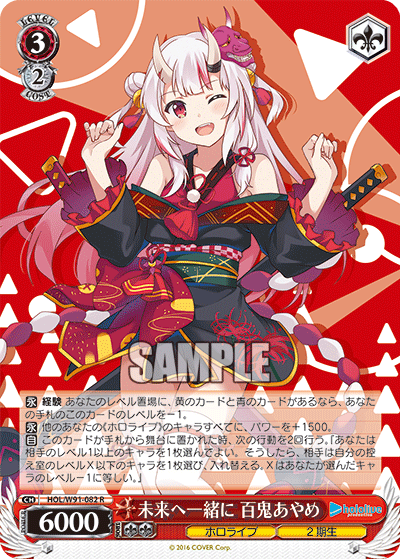
In comparison, profiles like the above are much more proactive in nature. Some of them only work during your turn while others, such as the clean cut, can actually work during your opponent’s turn (in a less effective way). While profiles like clean cut can be reacted to by your opponent, given that you are on the play, you can use other profiles to stun or trap cards to prevent your opponent from denying its condition. Profiles like level down are far more punishing, denying a defensive utility piece or downgrading a card immediately, forcing your opponent to either pay encore costs to restore their card and ruining the day of any characters that had a cross-turn ability or require markers (flickering and moving characters to zones other than the field will “reset” the character).
Even if the profiles such as the clean cut are dependent on reversing conditions, they are usually much easier to fulfill rather than relying upon defensive utility. You don’t have to wait until your opponent’s turn to get a chance at activating its ability.



KMD/W96-053MDR-MDR 休日のお出かけ トール&カンナ&小林さん (center)
GIM/W124-P03PR 「かちどき」藤田ことね (right)
Honestly, I don’t think there’s any one-size-fits-all profile. Everything depends on context. Coinflip profiles are considered very good since they provide potential value during your opponent’s turn. The name coinflip implies they have a modified chance of going off. The problem is that the value of these cards is dependent on a variety of factors on whether they have a better primary ability or your deck can make use of their bouncing effects back to hand if they have any. Personally, the profiles above are some of my favourites.
Kobeni is an enhanced coinflip that carries much more risk. Kobeni mills three cards exactly, and if all three cards are characters relating to the traits written on her card, she comes back to hand for free. Kobeni is perfect in my opinion for two reasons. Firstly, it is nice if she comes back to hand, giving me additional value during my opponent’s turn. Secondly, if my deck requires targets in waiting room, Kobeni provides that much wanted assisted mill for later turns. In some cases, she can even mill me into a new deck if need be. Kobeni activates like many other coinflips at the start of my opponent’s draw phase, securing the ability if it procures, and sending it back to my hand without my opponent’s intervention. Arguably a profile like Kobayashi’s trio works pretty much the same way. Unlike runners, this profile doesn’t open a slot and reduces damage as if it’s being fronted while also returning the card back to my hand. Lastly, Kotone is a stock reverser with a major boost during my turn. She gains a soul and is able to swing for additional damage or side a target without any worry. She becomes a problem my opponent has to deal with ideally on their turn.
Aside from the chance conditions on some of these cards, the reason why I chose to display these profiles is because of the way they offer value to the player while also reducing need to worry about interaction during your opponent’s turn. Their costs can often be used as ways to improve gameplay, which, while not hindering your opponent’s, gives an upside whether or not they activate entirely. This is how I feel players should consider their choices when building their decks. Rather than focusing entirely on what’s best in their series, they should consider what is best for their deck and think less about hindering their opponent and more of what gives them advantage.
Sometimes costs can be considered an upside. And even if it costs a bit of risk, the payoff may be well worth it in the long run.
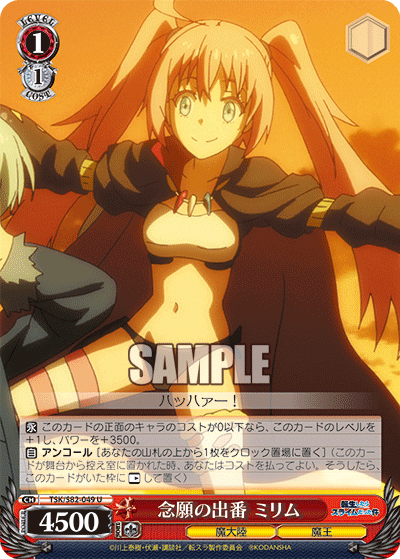

One last profile I want to show is that of the 1/1 that cannot be reversed by cost zero characters. Now, in all fairness, these cards essentially function the same way as that of any 1/1 with large power. However, the fact that they cannot be reversed by any cost zero dramatically changes the way these cards affect the board. In reality, most modern decks don’t carry many costed cards before level two outside of standby decks. These 1/1 profiles can often run entirely free uncontested on board simply because your opponent either doesn’t have the means to deal with them or it’s not worth it in their interests.
In my opinion, these cards truly exhibit the best form of passive protection. They are defensive by nature, but they can also be on the offensive. There are some reversers that can break through the mold, especially if they target the level instead of cost and can move cards between zones other than the waiting room, but in this day and age, they are relatively rare. 1/1 cards like the above essentially run free in most modern matchups focused on heavy player advantage. They cost a small commitment, a single stock, and make back the value assuming they stay on board for a few turns (sometimes even into the endgame).
I think cards like Milim especially are extremely frustrating and annoying to play against. You see, Milim gains a level against costless cards, nullifying one of the best mechanics in the game: siding. Your opponent will, most of the time, deal no damage if they choose to side against cards like Milim, essentially nullifying an entire attack or opening a slot to receive more damage during your turn. Either way, you get to keep Milim around.
Ultimately, does that mean that you should run all the profiles I’ve listed. Well, if you’ve been reading the post, it depends. If these cards suit you, benefit your deck, or work well in your local meta, you should give these profiles and others a chance. Defensive utility, for the most part, rarely ever gives you as much of an advantage as proactive play. Many players transitioning into Weiss, especially from the games I listed at the beginning of this post, struggle to come to terms with this. Weiss isn’t really a reactive game. You usually build a field and push for a certain deck state and then ask your opponent to deal with it.
Does that necessarily mean that you should abandon all defensive utility? The answer is also no. Everything depends on the situation and the deck that you are playing. Some defensive utility may better suit your deck and playstyle. Weigh your own options yourself and perform some deck testing with some games. The bottom line is this: you should be always looking to push your advantage rather than trying to lock your opponent out of theirs. There is no best-in-slot card or profile.

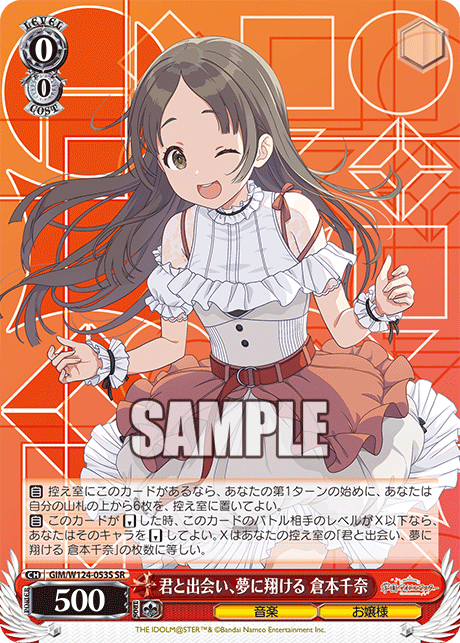
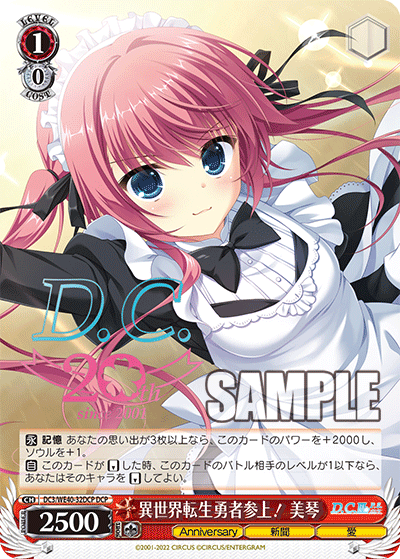
GIM/W124-053S-SR 君と出会い、夢に翔ける 倉本千奈 (center)
DC3/WE40-32DCP-DCP 異世界転生勇者参上! 美琴 (right)
It may really surprise you, but some of the cards that you’d think are just gimmicky or provide a one-off effect may generally provide you with some extra special utility or power that you’ve been missing out on all this time. Read into your series and give some cards a chance!